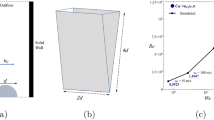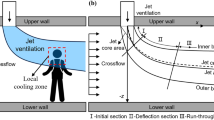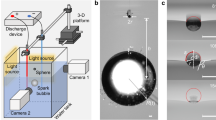Abstract
When a heavy sphere is dropped onto a bed of loose, fine sand, a remarkable phenomenon occurs: a large, focused jet of sand shoots upwards1,2,3,4. Although similar looking jets are observed on impact in fluid systems5,6,7, they are held together by surface tension. Surprisingly, the granular jet exists in the absence of both surface tension and cohesion, thus fluid jet models are of limited use. Previous work1,2 proposed that the jet is created solely by the gravity-driven collapse of a void left by the sphere’s descent through the pack. Here we present experimental evidence that granular jets are instead driven by a more complex process involving the interaction between the sand and interstitial air. Using high-speed X-ray radiography, and high-speed digital video, we observe the formation of the jet both inside and above the bed. We find that what previously was thought of as a single jet in fact consists of two components: a wispy, thin jet that varies little with pressure followed by a thick air-pressure-driven jet. This is further evidence that qualitatively new phenomena in granular systems can emerge as a function of air pressure8,9,10,11. Our results highlight the importance of the dynamic coupling between gas and granule motion.
This is a preview of subscription content, access via your institution
Access options
Subscribe to this journal
Receive 12 print issues and online access
$259.00 per year
only $21.58 per issue
Buy this article
- Purchase on SpringerLink
- Instant access to full article PDF
Prices may be subject to local taxes which are calculated during checkout



Similar content being viewed by others
References
Thoroddsen, S. T. & Shen, A. Q. Granular jets. Phys. Fluids 13, 4–6 (2001).
Lohse, D. et al. Impact on soft sand: Void collapse and jet formation. Phys. Rev. Lett. 93, 198003 (2004).
Lohse, D., Rauhe, R., Bergmann, R. & van der Meer, D. Creating a dry variety of quicksand. Nature 432, 689–690 (2004).
Walsh, A. M., Holloway, K. E., Habdas, P. & de Bruyn, J. R. Morphology and scaling of impact craters in granular media. Phys. Rev. Lett. 91, 104301 (2003).
Worthington, A. M. A Study of Splashes (Longman and Green, London, 1908).
Zeff, B. W., Kleber, B., Fineberg, J. & Lathrop, D. P. Singularity dynamics in curvature collapse and jet eruption on a fluid surface. Nature 403, 401–404 (2000).
Fedorchenko, A. I. & Wang, A. B. On some common features of drop impact on liquid surfaces. Phys. Fluids 16, 1349–1365 (2004).
Pak, H. K., Vandoorn, E. & Behringer, R. P. Effects of ambient gases on granular-materials under vertical vibration. Phys. Rev. Lett. 74, 4643–4646 (1995).
Möbius, M. E., Cheng, X., Karczmar, G. K., Nagel, S. R. & Jaeger, H. M. Intruders in the dust: Air-driven granular size seperation. Phys. Rev. Lett. 93, 198001 (2004).
Yan, X., Shi, Q., Hou, M., Lu, K. & Chan, C. K. Effects of air on the segregation of particles in a shaken granular bed. Phys. Rev. Lett. 91, 014302 (2003).
Burtally, N., King, P. J. & Swift, M. R. Spontaneous air-driven separation in vertically vibrated fine granular mixtures. Science 295, 1877–1879 (2002).
Darcy, H. P. G. Les Fontaines Publiques de la Ville de Dijon (Victor Dalmont, Paris, 1856).
Carman, P. C. Flow of Gases Through Porous Media (Butterworths Scientific, London, 1956).
Dullien, F. A. L. in Handbook of Powder Science and Technology (eds Fayed, M. E. & Otten, L.) (Van Nostrand Reinhold, New York, 1984).
Acknowledgements
We thank F. Blanchette, E. Clement, B. Conyers, K. Foster, M. Möbius and S. Nagel for insightful discussions. This work was supported by NSF through its MRSEC program under DMR-0213745 and through its Inter-American Materials Collaboration under DMR-0303072. GSECARS is supported by National Science Foundation-Earth Sciences (EAR-0217473), Department of Energy Geosciences (DE-FG02-94ER14466), the State of Illinois and the W. M. Keck Foundation. Use of the Advanced Photon Source was supported by the US Department of Energy, Basic Energy Sciences, Office of Energy Research, under contract number W-31-109-Eng-38.
Author information
Authors and Affiliations
Corresponding author
Ethics declarations
Competing interests
The authors declare no competing financial interests.
Rights and permissions
About this article
Cite this article
Royer, J., Corwin, E., Flior, A. et al. Formation of granular jets observed by high-speed X-ray radiography. Nature Phys 1, 164–167 (2005). https://doi.org/10.1038/nphys175
Received:
Accepted:
Published:
Issue date:
DOI: https://doi.org/10.1038/nphys175
This article is cited by
-
Projection–Subtraction X-ray Imaging Scheme for Studying Fast Fluid-Dynamics Processes in Porous Media
Transport in Porous Media (2024)
-
Recent progress on the jetting of single deformed cavitation bubbles near boundaries
Journal of Hydrodynamics (2023)
-
Key connection between gravitational instability in physical gels and granular media
Scientific Reports (2022)
-
Impact of freely falling liquid containers and subsequent jetting
Experiments in Fluids (2022)
-
Geometrical description of impact cratering under microgravity conditions
Granular Matter (2022)



